Electronic toll collection technology was developed to eliminate delays on toll roads by collecting tolls electronically.
Recently, frequent traffic jams at Sirhaul Toll Plaza on Delhi-Gurugram expressway forced the district administration to close the 12-lane plaza permanently. People commuting from New Delhi to Gurugram and back recall the difficulty faced in passing through this toll plaza. Electronic toll collection technology could have increased the efficiency of the toll plaza and prevented its closure.
With increasing population, industrialisation, urbanisation and pace of life, there is a need to increase speed and efficiency of our transportation system. Establishment of toll roads has dynamically increased in tandem with expansion in road transportation networks. Toll plazas play a crucial role in maintaining the speed and efficiency of road transportation. Toll fee collected is used for expansion, operational and maintenance purposes.
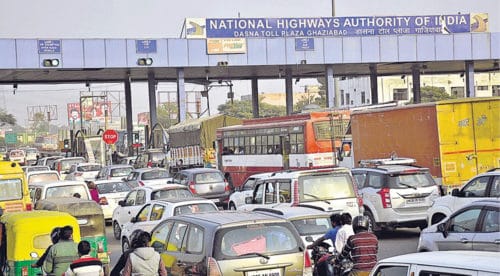
Traditionally, toll fee is collected manually via cash or card at dedicated toll booths. However, processing time at such plazas is extremely high due to manual intervention. This results in traffic jams and huge concentration of cars causing inconvenience to travellers. Processing times cannot be reduced much, as motorists are required to stop to pay the toll fee, collect the change and wait for the gate to open. This causes traffic congestions at toll plazas during peak hours, resulting in long waiting times, fuel inefficiency and sometimes road rage, which may lead to violence.
To avoid these traffic congestions, so far the most common effort made has been to widen the roads to alleviate traffic congestions. But, these initiatives are soon reaching their limit, bringing about the need for a fundamental system reform in toll collection methods, so that vehicles can drive through toll gates without stopping to pay the toll fee.
Demand for faster and greater vehicle throughput has resulted in new concepts where manual toll booths are giving way to all-electronic, non-stop, open road tolling. Electronic toll collection technology has been developed, which aims to eliminate the delays on toll roads by collecting tolls electronically.
This solution supports modern-day digital technologies that safeguard toll revenues. Beside replacing manual cash collections, it provides an enhanced customer experience by improving mobility, increasing safety and adding convenience. Electronic toll collection technology identifies whether the vehicles passing are enrolled in the program, alerts those that are not and electronically debits the accounts of registered users without requiring them to stop, eliminating inconvenient manual payment methods.
Electronic toll collection system has a number of advantages over conventional ones. This system contributes to society and the planet in a variety of ways. It helps in eliminating traffic congestions at toll gates by reducing queues (which result in reducing drivers’ stress borne from traffic jams), improving fuel consumption by avoiding vehicles to repeatedly stop and go, reducing noise around toll gates and reducing emission of exhaust gases, thus preventing global warming.
The system results in lowered toll collection costs, better audit control by centralised user accounts, expanded capacity without building more infrastructures and prevents the need to carry cash for payment of toll. It also helps the police and security forces to track and catch blocked cars.
Evolution of electronic toll collection system
Technologies associated with tolling have made rapid developments in the last 10 to 15 years. In present times, mounting and implementing a country-wide solution presents fewer technological risks. In 1959, Nobel Economics Prize winner William Vickrey proposed a system of electronic tolling in which each vehicle was equipped with a transponder.
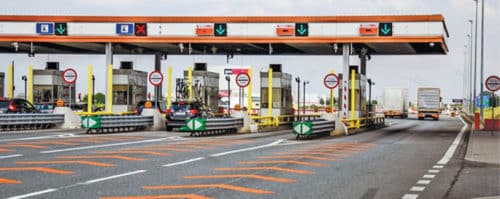
The transponder’s personalised signal was picked up as the vehicle passed through an intersection and relayed to a central computer, which calculated the charge according to the intersection and time of day, and added it to the vehicle’s bill.
In 1970s, free flow tolling was successfully tested with vehicles equipped with transponders at undersides and readers located under the surface of the highways.
Electronic toll collection technology was first introduced in Bergen, Norway in 1986, operating together with traditional toll booths.
The world’s first completely unaided full-speed electronic tolling system was introduced in 1991 at Trondheim.
In 1995, Portugal became the first country to apply a single, universal system to all tolls in the country.

The US is known for widespread use of electronic toll collection technology.
In 2005, Santiago, Chile became the world’s first city with 100 per cent full-speed electronic tolling with transponders in a system of several urban freeways.
In 2007, United Arab Emirates (UAE) implemented a similar road toll collection in Dubai.
Most modern methods now becoming popular are based on Global Positioning System (GPS). A GPS-based highway toll collection system uses a microcontroller (MCU), third-generation (3G) mobile communication connectivity, sophisticated algorithms and complex system integration.
In India, too, electronic toll collection technology is increasingly being made available on toll roads across the country.
Technologies used in an electronic toll collection system
Technologies used in a typical electronic toll collection system include the following major autonomous sub-systems:
Automated vehicle identification (AVI) system
AVI is the method for determining the identity of a vehicle when it is in the toll gate area. Earlier, bar codes were fixed to each vehicle, which were read optically at the toll booth. However, optical systems were found to have poor reading reliability, especially during bad weather conditions and in case of dirty vehicles.

Current AVI systems mostly rely on radio frequency identification (RFID), where an antenna at the toll gate communicates with a transponder fitted on the vehicle using dedicated short-range communication (DSRC). These have excellent accuracy and can be read at high speeds.
The major disadvantage is the cost of equipping each vehicle with a transponder, which can be a major start-up expense (if paid by the toll agency) or a strong customer deterrent (if paid by the customer).
However, recent models of vehicles are coming factory-fitted with transponders. To preclude the need for transponders, some systems use automatic number plate recognition. Here, a system of cameras captures images of vehicles passing through tolled areas, and images of the number plates are extracted and used to identify the vehicles. This allows customers to use the facility without any advance interaction with the toll agency.
One disadvantage is that the system has a significantly high error rate, giving rise to billing errors. Also, cost of transaction processing (locating and corresponding with customers) can be substantial. Systems based on a manual review stage have lower error rates but, these come with the burden of a continuing staffing expense.
Automated vehicle classification system
Usually, toll facilities have different rates for different types of vehicles. Therefore it becomes necessary to distinguish and classify the vehicles passing through these facilities.
The most common and low-cost method followed is storing vehicle class along with other details in the customer data record. The AVI system identifies a vehicle when it is in the toll gate area, and this AVI data is used to look up vehicle class.
A more complex system uses a variety of sensors. Inductive sensors embedded in the road surface determine the gaps between vehicles, to provide basic information on the presence of a vehicle. Treadles enable counting the number of axles as a vehicle passes over these. With offset-treadle installations, it can also detect dual-tyre vehicles. Light-curtain laser profilers are used to record the shape of the vehicle—this helps distinguish between, say, trucks and trailers.
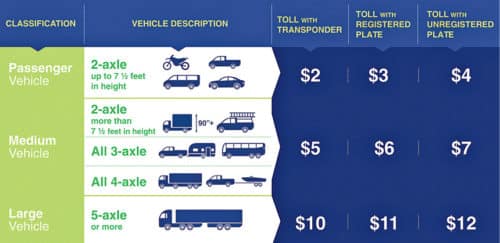
Transaction processing system
Transaction processing is used for maintaining customer accounts, posting toll transactions and customer payments to accounts, and handling customer inquiries. Customer accounts may be postpaid or prepaid. Postpaid accounts are where toll transactions are periodically billed to the customer. Whereas, prepaid ones are those where the customer funds a balance in his/her account, which is then depleted as toll transactions occur.
A prepaid system is more commonly used, as low amounts of most tolls makes follow up of uncollected debts expensive. A postpaid account usually insists on a security deposit, effectively rendering it prepaid. Transaction processing function is also referred to as customer service. In many ways, transaction processing function is like conventional banking—at times, toll agencies contract out transaction processing to a bank.
Violation enforcement system (VES)
An unmanned toll gate represents an appealing target for toll evasion. VES is used for reducing unpaid tolls. Several methods are in use to detect and discourage toll violators. Enforcement patrols are often deployed effectively at toll gates.
However, this can be quite expensive. A physical barrier, such as a gate arm, can be employed to ensure that all vehicles passing through the toll booth pay the required toll. Violators get identified immediately, as the barrier does not allow them to proceed. However, barriers also require authorised customers, which are the mainstream of vehicles passing through, to slow down to a near-stop at the toll gate, adversely affecting many of the benefits of electronic tolling.
Automatic number plate recognition can also be used for violation enforcement. A small number of images of violators collected makes manual review quite practical. However, there may be legal hurdles to permit this type of enforcement, as the number plate identifies only the vehicle, not its operator, and traffic enforcement regulations may require identifying the operator to take legal action.
Electronic toll collection system using RFID
In most cases, two methods of collecting toll are generally used. First is the common manual method, where the vehicle passing through the toll plaza stops, and one person collects money and issues a receipt.
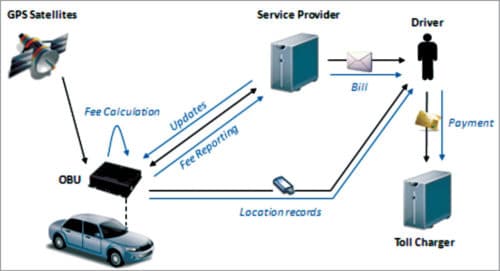
The other method is the cashless RFID-based system for automatic collection of toll. In this method, vehicles passing through need not stop and interact with a person to pay the toll. The toll is automatically deducted from their accounts.
Separate electronic toll collection lanes are set up, equipped with scanners that continuously send out RF electronic pulses. These pulses identify each vehicle that is travelling through the toll plaza with an electronic transponder (RFID tag in the form of a smart card), having all required information/data regarding the user’s account, fitted on the windshield of the vehicle.
RF pulses are reflected on hitting a tag and are received by the antenna of the scanner. These reflected pulses from the tag contain information about the user’s vehicle number, account, balance and so on. After encrypting the pulses, the toll plaza sends these to a central location, where computers connected to a central server process the information received to detect the unique identification number of the vehicle and the balance available in the user’s account. Then, the required toll amount is deducted from the user’s account.
The RFID tag-based system carries out the functions of automatic toll collection and detection of vehicle theft, any violation of traffic signals by vehicles, including over-speeding vehicles. When registering a vehicle, a smart card with an RFID-enabled tag with a unique ID is provided to the owner, to be used exclusively with this vehicle. The service provider creates an account for that smart card and maintains transaction history in its database. The owner of the vehicle needs to maintain a minimum balance in the account. Every time the registered vehicle approaches the toll booth, sensors at the toll gate detect the presence of the vehicle and activate the system to read the RFID smart card and calculate the toll fee to be paid by the vehicle. If the balance is available, toll fee is deducted directly; if not, the vehicle is directed to another lane to pay the toll manually. The software updates the details in the centralised database server and triggers a mechanism to generate the bill, which is sent to the user as text message.
If a vehicle owner registers a stolen vehicle complaint on the website using its registration ID and unique RFID tag number, an entry is made in the database. If, and when, the stolen vehicle passes through toll plaza, the ID of the tag fixed on it matches with the stolen vehicle’s tag ID in the database of the server and the vehicle gets identified as stolen.
All toll plazas must be connected to each other with a centralised server in the form of LAN. Updates of any sort of transaction are immediately updated in the server. Any vehicle violating traffic signals is detected by RFID readers fixed at signal crossings, and the traffic police get notified. Also, any vehicle travelling beyond the legal speed limit can be tracked.
Electronic toll collection system based on GPS
GPS-based system is an innovative combination of satellite-based GPS and Global System for Mobile telecommunication (GSM) technologies. GPS technology is used to find the position of a vehicle. It works in almost any condition and is accurate within 3 to 15 metres.
GPS-based electronic toll collection system consists of automatic toll collection system (ATCS), RF transmitter, toll gate and an on-board unit (OBU) mounted in the vehicle. The OBU includes an MCU, a GPS receiver and a GSM unit. It automatically determines the distance driven on the toll route by using GPS satellite signals and other positioning sensors. It then calculates the toll to be paid and transmits this information to the ATCS for further processing.
The OBU is supported with required software, electronic road maps, user data and data related to toll charges for the roads. When the vehicle approaches the toll road, information is transmitted to the Android device through GSM module, and a voice call and/or an alert SMS is sent to the user.
The on-board LCD displays vehicle details and other selected texts. An alert message or voice output enables the user to decide whether to quit the toll road (if alternate toll-free road is available) or continue using it. If the user decides to continue, a pre-determined toll amount is deducted automatically from the account on exiting the toll gate. Toll amount charged is based on the vehicle’s emission category, number of axles and length of the toll route.
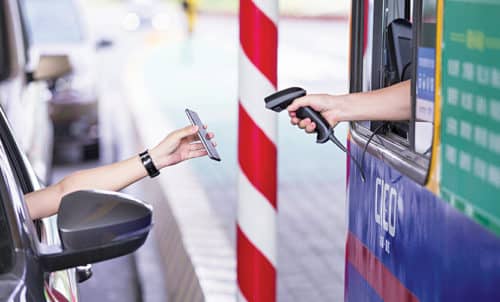
Vehicle position data is approved by GPS system and delivered to ATCS by GSM network. The MCU takes input location of the vehicle from GPS, compares it with the position of the toll plaza and updates vehicle database in ATCS. Once the system verifies that the vehicle is registered in the database, the RF transmitter sends the signal to the toll unit to open the toll gate. Thereafter, toll charge is debited from the account of the user and it is acknowledged with an SMS to the customer. If there is no balance in the account of the user, the bill is sent to the user with a fine. If the vehicle is found not registered in the database, it is diverted to the manual toll collection booth.
International technical specification
Technical specification ISO/TS 12813:2009 Electronic Fee Collection – Compliance Check Communication For Autonomous Systems was recently issued by International Organization for Standards (ISO). It lays down the specifications and requirements that an electronic toll collection system must confirm to, to be certified as a world-class system.
The standard helps in harmonising various systems to facilitate mobility between different road networks and to ensure reliable data collection and proper charging. It covers the interface between the OBU and roadside equipment, information data flow between operators, and electronic toll collection systems based on DSRC, GSM, Global Navigation Satellite Systems (GNSS) and integrated circuit (IC) card technologies. The standard includes not only the requirements but also the associated test procedures to support conformity evaluation of the systems. It also includes security guidelines that can be useful in the preparation or evaluation of security requirements.
End note
Today, toll-related technologies can leverage mobile telecommunication networks that make operational processes such as online registration and account topup a lot simpler. However, capital expenditure (CAPEX), that is, preliminary cost of technology and establishment of the system and operational expenditure (OPEX), that is, expense of upholding online connection, Multimedia Messaging Service (MMS) and customer support costs are likely to become considerable.
Many different technologies are competing. For example, ANPR method, which is also known as video tolling, is an evolved technology and has already been deployed to some extent in Europe.
Smartphones and other mobile communications hold a great promise in terms of being deployed, given the high penetration among users. However, there are hurdles such as ascertaining that smartphones should exchange data with vehicles to ensure correct functioning in secure mode, and that these should be plugged to an energy source. This would tantamount to an intricate integration of various products that have diverse life cycles.
Also, as autonomous and connected vehicles materialise commercially, it is probable that automobiles will be ready with added short-range communication devices that use vehicle-to-anything (V2X) communication protocols [include vehicle-to-vehicle (V2V) and vehicle-to infrastructure (V2I) communications] in the 5.9GHz frequency band. Perhaps, this could be facilitated to sustain tolling in the future.
Deepak Halan is associate professor at School of Management Sciences, Apeejay Stya University





